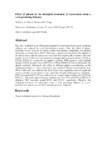Effect of phenol on the biological treatment of wastewaters from a resin producing industry

Use this link to cite
http://hdl.handle.net/2183/13699Collections
- Investigación (FCIE) [1229]
Metadata
Show full item recordTitle
Effect of phenol on the biological treatment of wastewaters from a resin producing industryDate
2008-06Citation
Eiroa M, Vilar A, Kennes C, Veiga MC. Effect of phenol on the biological treatment of wastewaters from a resin producing industry. Bioresour Technol. 2008;99(9):3507-12.
Abstract
The effect of phenol on the biological treatment of wastewaters from a resin producing industry was analyzed in a pre-denitrification system. First, the effect of phenol overloads on the removal of organic matter and nitrogen compounds was studied. During the overloads (from 250 to 4000 mg/L), phenol was detected in the effluent of the anoxic reactor but the system recovered fast after stopping the overloads. The total organic carbon (TOC) removal remained unchanged during phenol addition (91.9% at 0.20 kg TOC/m3 d), except for the highest overload. With regard to total Kjeldahl nitrogen (TKN), its mean removal (87.9% at 0.08 kg TKN/m3 d) was not affected by the phenol overloads. Afterwards, the effect of different phenol concentrations on the biological treatment of these wastewaters was analyzed. Phenol concentrations from 250 to 4000 mg/L were added to the feed. Phenol was completely removed despite the presence of other carbon sources in the wastewater. In spite of the presence of phenol, a TOC removal around 91.3% was achieved at an average organic loading rate of 0.11 kg TOC/m3 d. The mean applied nitrogen loading rates were 0.05 and 0.08 kg TKN/m3 d, obtaining TKN removals around 85.8% and 87.1%, respectively. Therefore, the biological treatment of wastewaters from a resin producing industry in a pre-denitrification system was not affected by the presence of phenol.
Keywords
Phenol
Industrial wastewater
Biological treatment
Industrial wastewater
Biological treatment





